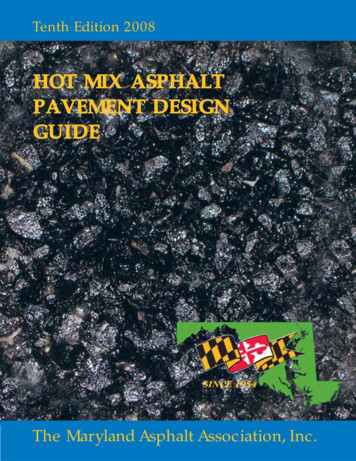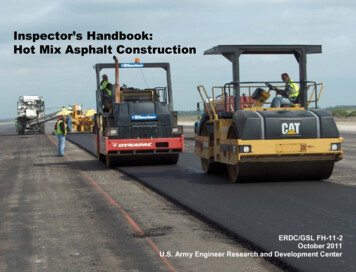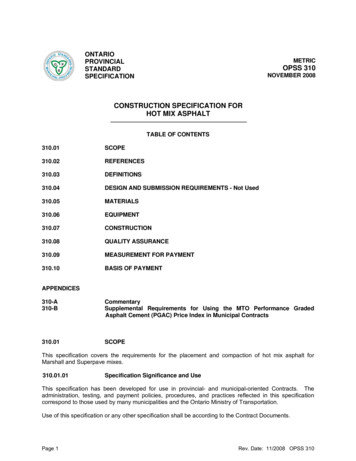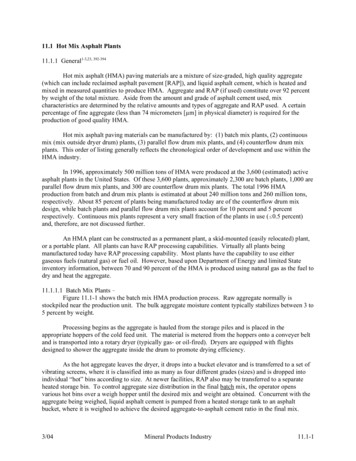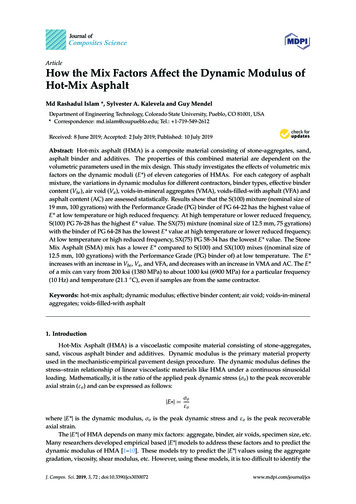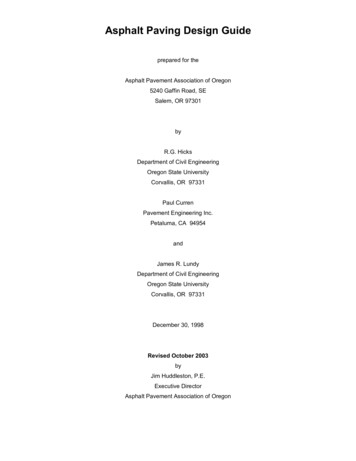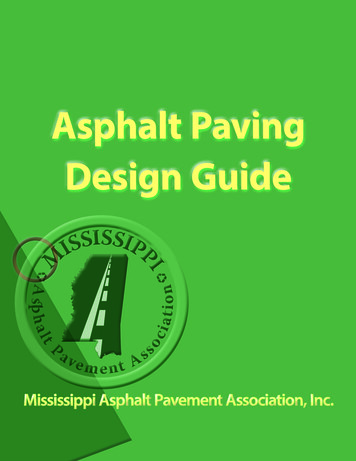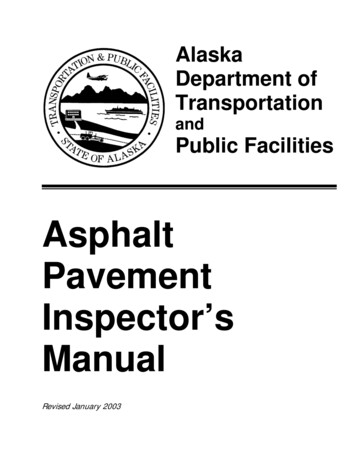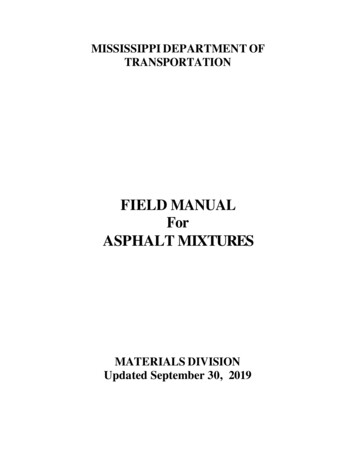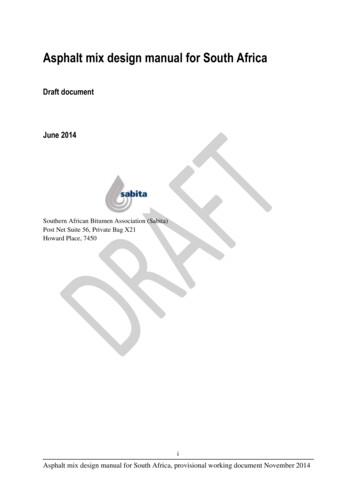
Transcription
Asphalt mix design manual for South AfricaDraft documentJune 2014Southern African Bitumen Association (Sabita)Post Net Suite 56, Private Bag X21Howard Place, 7450iAsphalt mix design manual for South Africa, provisional working document November 2014
TABLE OF CONTENTSPREFACE . ixACKNOWLEDGEMENTS .xLIST OF ABBREVIATIONS . xi1.INTRODUCTION. 1-11.1Aims of asphalt mix design . 1-11.2Performance-related asphalt mix design . 1-11.3Simplification . 1-21.4Design approach . 1-21.5Link to pavement design . 1-31.6Scope and structure of the manual . 1-42.MIX TYPE SELECTION . 2-52.1Asphalt mix types . 2-52.22.1.1Sand skeleton mixes . 2-52.1.2Stone skeleton mixes . 2-5Factors impacting on selection of asphalt type . 2-52.2.1Traffic considerations . 2-52.2.2Layer thickness and maximum particle size . 2-32.2.3Climatic considerations . 2-42.2.4Other considerations . 2-52.3Mix design consideration and mix type selection. 2-83.BINDER SELECTION. 3-103.1PG binder classification system . 3-103.1.1Temperature . 3-103.1.2Traffic . 3-123.1PG binder selection . 3-143.2Binder selection for specific mix types . 3-143.2.1EME . 3-143.2.2Sand asphalt . 3-143.2.3Asphalt for lightly trafficked roads in residential areas . 3-143.2.4Porous asphalt mixes . 3-153.2.5Bitumen rubber asphalt . 3-15iiAsphalt mix design manual for South Africa, provisional working document November 2014
3.2.6Warm mix asphalt . 3-153.2.7Reclaimed asphalt binder . 3-154.AGGREGATE SELECTION . 4-14.1Aggregate materials . 4-14.2Definitions . 4-14.3Aggregate sources . 4-14.3.1Natural aggregates . 4-14.3.2Processed aggregates . 4-14.3.3Manufactured aggregates . 4-14.3.4Fillers . 4-24.4Aggregate grading . 4-34.5Grading requirements . 4-44.5.1Grading control points . 4-44.5.2Primary control sieves . 4-64.6General requirements and specifications for aggregates . 4-64.7Preparation and selection of aggregate grading . 4-74.8Surface area of aggregate. 4-85.MIX DESIGN . 5-15.1Introduction. 5-15.2Asphalt mix properties . 5-15.2.1Workability . 5-15.2.2Durability . 5-15.2.3Stiffness . 5-25.2.4Resistance to permanent deformation (Rutting) . 5-25.2.5Resistance to fatigue cracking . 5-25.2.6Permeability . 5-35.2.7Thermal fracture . 5-35.3Composition of asphalt . 5-35.4Volumetric properties and definitions . 5-35.5Mix design levels . 5-55.65.5.1Level I mix design process . 5-75.5.2Level II and Level III design process . 5-12Design of special mixes . 5-165.6.1Cold mixes . 5-16iiiAsphalt mix design manual for South Africa, provisional working document November 2014
5.6.2Porous asphalt . 5-165.6.3Mixes for light traffic in residential areas . 5-165.6.4Warm mix asphalt . 5-165.6.5EME asphalt . 5-165.6.6Mixes with reclaimed asphalt . 5-165.6.7Stone mastic asphalt (SMA) . 5-166.LINK WITH ASPHALT PAVEMENT DESIGN . 6-16.1South Africa pavement design method . 6-16.2Asphalt pavement layer considerations . 6-16.3Resilient response of asphalt . 6-16.3.1Binder ageing model . 6-26.3.2Predicting dynamic modulus of asphalt . 6-36.4Predicting permanent deformation . 6-66.5Predicting fatigue cracking . 6-66.6Temperature prediction models . 6-66.6.1Maximum surface temperature . 6-66.6.2Minimum surface temperature . 6-76.6.3Asphalt temperature at depth . 6-76.6.4Loading time . 6-86.7Long life pavement . 6-87.QUALITY CONTROL, QUALITY ASSUARANCE AND ACCEPTANCE . 7-17.1General . 7-17.2Definitions . 7-17.2.1Quality control . 7-17.2.2Quality assurance . 7-17.3Levels of mix design . 7-17.4Mix design level I . 7-27.57.4.1Laboratory design . 7-27.4.2Plant mix . 7-37.4.3Trial section . 7-47.4.4Field/site: Quality control . 7-5Level II and Level III design . 7-77.5.1Mix certification . 7-77.5.2Trial section . 7-87.5.3Site/field: Quality control . 7-9ivAsphalt mix design manual for South Africa, provisional working document November 2014
7.6Test methods . 7-107.7Asphalt paving and construction factors affecting quality control . 7-127.7.1Compaction. 7-127.7.2Temperature . 7-127.7.3Segregation . 7-127.8Functional mix acceptability. 7-128.REFERENCES AND BIBLIOGRAPHY . 8-1Aggregate grading .1Definitions.1Unit weight of aggregates .1Loose and rodded unit weight voids .
The increasing use of mix types that cannot be classified as conventional Hot-Mix Asphalt (HMA) and that require alternative design methods. Such mix types would include warm mix, cold mix, mixes with significant proportions of reclaimed asphalt, stone mastic asphalt and Enrobé à Module Élevé (EME) asphalt. This is the reason for the shift in focus in this manual

